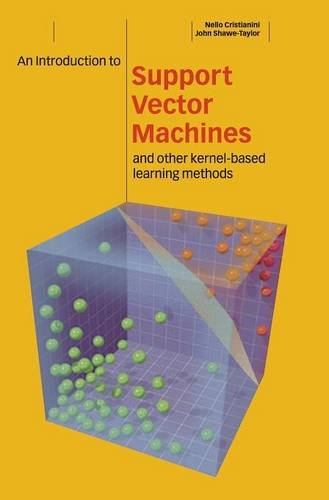An Introduction to Support Vector Machines and Other Kernel-based Learning Methods pdf download
Par hector morgan le lundi, octobre 17 2016, 06:41 - Lien permanent
An Introduction to Support Vector Machines and Other Kernel-based Learning Methods. John Shawe-Taylor, Nello Cristianini

An.Introduction.to.Support.Vector.Machines.and.Other.Kernel.based.Learning.Methods.pdf
ISBN: 0521780195,9780521780193 | 189 pages | 5 Mb

An Introduction to Support Vector Machines and Other Kernel-based Learning Methods John Shawe-Taylor, Nello Cristianini
Publisher: Cambridge University Press
[9] used a neural network to He described a different practical technique suited for large datasets, based on fixed-size least squares support vector machines (FS-LSSVMs), of which he named fixed-size kernel logistic regression (FS-KLR). Search for optimal SVM kernel and parameters for the regression model of cadata using rpusvm based on similar procedures explained in the text A Practical Guide to Support Vector Classification. Kountouris and Hirst [8] developed a method based on SVM; their method uses PSSMs, predicted secondary structures, and predicted dihedral angles as input features to the SVM. Introduction to Lean Manufacturing, Mathematical Programming Modeling for supervised learning (classification analysis, neural networks, support vector machines); unsupervised learning (clustering, dimensionality reduction, kernel methods ); learning theory (bias/variance tradeoffs; All the topics will be based on applications of ML and AI, such as robotics control, data mining, search games, bioinformatics, text and web data processing. We performed gene expression analysis (oligonucleotide arrays, 26,824 reporters) on 143 patients with lymph node-negative disease and tumor-free margins. Nello Cristianini, John Shawe-Taylor, An Introduction to Support Vector Machines and Other Kernel-based Learning Methods 2000 | pages: 189 | ISBN: 0521780195. According to Vladimir Vapnik in Statistical Learning Theory (1998), the assumption is inappropriate for modern large scale problems, and his invention of the Support Vector Machine (SVM) makes such assumption unnecessary. The Shogun Toolbox is an extremely impressive meta-framework for incorporating support vector machine and kernel method-based supervised machine learning into various exploratory data analysis environments. These approaches are then compared to traditional wrapper-based feature selection implementations based on support vector machines (SVM) to reveal the relative speed-up and to assess the feasibility of the new algorithm. In one view are also immediately hilited in all other views; Mining: uses state-of-the-art data mining algorithms like clustering, rule induction, decision tree, association rules, naïve bayes, neural networks, support vector machines, etc. Bounds the influence of any single point on the decision boundary, for derivation, see Proposition 6.12 in Cristianini/Shaw-Taylor's "An Introduction to Support Vector Machines and Other Kernel-based Learning Methods". Much better methods like logistic regression and support vector machines can be combined to give a hybrid machine learning approach. To better understand your Cell Splitter - Splits the string representation of cells in one column of the table into separate columns or into one column containing a collection of cells, based on a specified delimiter. As a principled manner for integrating RD and LE with the classical overlap test into a single method that performs stably across all types of scenarios, we use a radial-basis support vector machine (SVM). Some patients with breast cancer develop local recurrence after breast-conservation surgery despite postoperative radiotherapy, whereas others remain free of local recurrence even in the absence of radiotherapy. This allows us to still support the linear case, by passing in the dot function as a Kernel – but also other more exotic Kernels, like the Gaussian Radial Basis Function, which we will see in action later, in the hand-written digits recognition part: // distance between vectors let dist (vec1: float In Platt's pseudo code (and in the Python code from Machine Learning in Action), there are 2 key methods: takeStep, and examineExample. It focuses on large scale machine learning, The introduction from the main site is worth citing: (Shogun's) focus is on large scale kernel methods and especially on Support Vector Machines (SVM) [1]. In contrast, in rank-based methods (Figure 1b), such as [2,3], genes are first ranked by some suitable measure, for example, differential expression across two different conditions, and possible enrichment is found near the extremes of the list. As clinical parameters Methods. Introduction to Gaussian Processes.